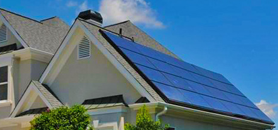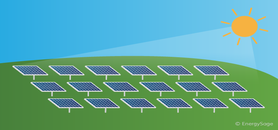Cost of electricity in Indianapolis, IN
Why you can trust EnergySage
The data on this page comes from real solar quotes to real solar shoppers on the EnergySage Marketplace. We give you access to transparent information so you can confidently make informed energy decisions. Learn more about how our Marketplace works and how we make money.
On average, Indianapolis, IN residents spend about $183 per month on electricity. That adds up to $2,196 per year.
That’s 13% lower than the national average electric bill of $2,514. The average electric rates in Indianapolis, IN cost 16 ¢/kilowatt-hour (kWh), so that means that the average electricity customer in Indianapolis, IN is using 1,132.00 kWh of electricity per month, and 13584 kWh over the course of the year.
Electric rates in Indianapolis, IN
This data is aggregated over the past 6 months.
Key takeaways about electric rates in Indianapolis, IN
- Over the next 25 years, you should expect to pay $81,000 on electric bills in Indianapolis, IN.
- You can reduce your electric bill by using less electricity or by reducing the cost of your electricity (like by installing a solar system).
- If you install a solar system, on average, you’ll break even on your solar investment in 13.84 years in Indianapolis, at which point you may not owe anything on your electric bills.
Electric bill savings with solar in Indianapolis, IN
Solar saves you money by reducing or eliminating your monthly electric bill. The amount that you can save with solar in Indianapolis, IN is based on two factors: how much you spend on electricity now and how much of your electric bill you can offset with solar.
Based on the intensity and amount of sunlight hours in Indianapolis, IN, the average electricity customer in Indianapolis, IN will need a 9.9 kilowatt (kW) solar panel system to offset 100% of their annual electricity consumption of 13584 kWh per year. On the EnergySage Marketplace, solar shoppers in Indianapolis, IN pay an average of $32,000 for a 9.9 kW solar panel system prior to incentives.
The savings from offsetting 100% of an electric bill with solar can add up fast! Assuming an 3.1% annual increase in electricity prices and that you install your system with a $0-down loan, you can expect to save $2,200 in your first year, $11,700 over five years, $25,300 over 10 years, and $59,600 over 20 years on electric bills in Indianapolis, IN. Over your system’s lifetime you’ll save more by financing your solar system with a cash purchase, but you won’t start saving in year one. Learn more about how to finance your solar panel system.
How much can you save by going solar in Indianapolis, IN?
Find out what solar panels cost in your area in 2025
Electric bills in Indianapolis, IN



Monthly electric bills are a product of how much electricity you use per month and your electric rate. In Indianapolis, IN, the average monthly electric bill for residential customers is $183/month, which is calculated by multiplying the average monthly consumption by the average electric rate: 1,132.00 kWh * 16 ¢/kWh.
Electric bills are designed to cover all of the costs of producing the electricity that you use, of running and maintaining the electrical grid to help prevent outages, and of any public benefit funds that promote things like renewable energy and energy efficiency. These costs are rolled into both fixed charges (i.e., monthly customer charges) and variable charges (i.e., ¢/kWh that you use). While fixed charges will remain the same from month to month, the portion of variable charges on your bill each month will change based on how much electricity you use. As a result, there are two ways to reduce your bills: by either using less electricity or by reducing the cost of electricity, by installing solar for instance.
Electric rates in Indianapolis, IN
The easiest way to compare the cost of electricity from one region to another is to look at the electricity rate. Residential rates in the U.S. range from 6 ¢/kWh to 71 ¢/kWh depending upon where you live, what types of power plants provide your electricity, and when during the day or year you’re consuming electricity.
The average residential electricity rate in Indianapolis, IN is 16 ¢/kWh, which is 4% lower than the average electricity rate in Indiana of 16.80 ¢/kWh. The average residential electricity rate in Indianapolis, IN is 17% lower than the national average rate of 20 ¢/kWh.
How solar helps you save on electric bills
Solar panel systems help you save money by reducing your monthly electric bills. Although a $50 or $100 electric bill might not seem like much when you pay it each month, those bills add up quickly over ten, twenty or even thirty years: if you pay $100 per month in electricity now, you’ll pay over $58,000 on electricity over the next thirty years!
| EXISTING ELECTRIC BILL | 10 YEAR COST | 20 YEAR COST | 30 YEAR COST |
|---|---|---|---|
| $50 | $6,900 | $16,000 | $29,000 |
| $100 | $14,000 | $33,000 | $58,000 |
| $150 | $21,000 | $49,000 | $87,000 |
| $200 | $28,000 | $65,000 | $120,000 |
| $250 | $35,000 | $81,000 | $150,000 |
Assuming a 3.1% annual increase based on inflation and average annual electric rate increases.
Installing solar allows you to reduce or even eliminate your electric bill: when you pay upfront for solar panels, you are effectively paying today for the electricity you’ll use over the next 25 or even 30 years. Calculating your savings from investing in solar is as simple as subtracting the amount you pay for solar from what you would have paid for electricity otherwise.
EnergySage can help you go solar and save!
We know electric bills add up over time, and going solar is a great way to save money while helping the environment. When you sign up on the EnergySage Marketplace, you'll be able to receive and compare solar quotes side-by-side from qualified solar installers in your area. We're here to help along the way - talk with one of our Energy Advisors to learn more about your unique quotes, any local solar incentives you may be eligible for, or any other questions about saving on electric bills with solar.
Frequently asked questions about electric rates and solar
Recommended for You

Compare solar panels from leading brands

Save money with renewable energy by subscribing to a community solar farm

Learn the basics of solar energy for your home so you can compare quotes with confidence